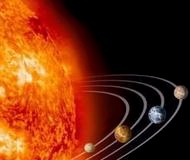
|
|||
| Contents | Prev | Next | |
![]()
2. Earth with 2 Sunrises and 2 Sunsets (The Night Sun)

Now we will see how the situation on Earth was when the second sun was functioning normally.
Oxygen isotope data from ancient sedimentary rocks suggest that the early
Earth was much hotter than today: "according to oxygen isotope records, early
Earth surface temperatures could have been as high as 45 – 85 degrees C!"
atoc.colorado.edu
On the other hand, it is said that the early Sun was cool, giving only about 70% of solar heat, or even less. So where did the extra heat on the earth come from? Many theories have been suggested, but without any supporting evidence at all. (space.com)
In the present time a day on the Earth is 24 hours, but the early Earth's day
is said to be much shorter. It was about five to six hours only. One theory
suggests that a large object, in the size of Mars, impacted the Earth and set it
to spin very fast. But there is no sign of such a large object to ever hit the
earth: "Scientists estimate that a day in the life of early Earth was only
about 6 hours long."
spaceplace.nasa.gov
Now we have alternative explanations, the early earth was not rotating so rapidly, it is just the other sun made the day seems very short; one sun sets and the other sun rises. Regarding the early Earth's surface temperature, the extra heat was coming from the second sun.
![]()
| The full report in a single page | ||
| Contents | Prev | Next |

